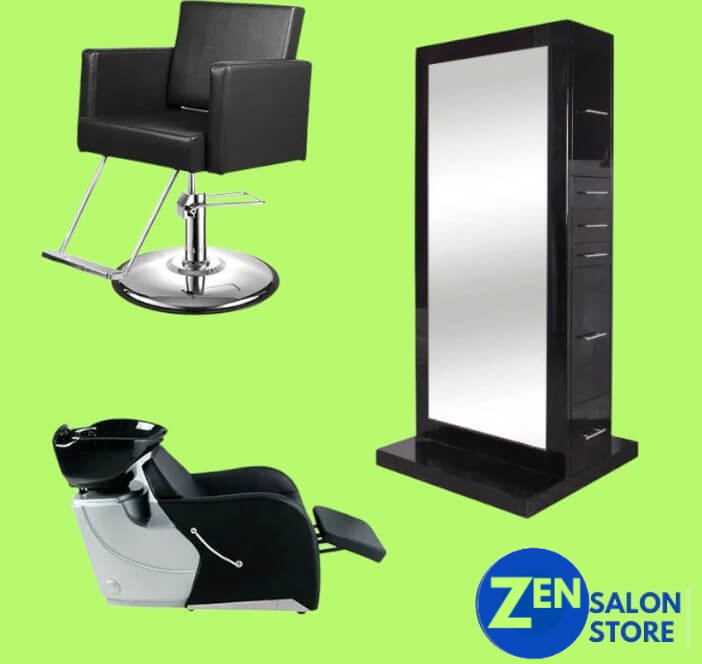
Salon Equipment List UK: What You Need to Get Started
Share
Opening a UK salon takes more than creative vision — it takes the right foundation. Behind the mood boards and brand colours, you're facing real pressures: rising energy bills, health and safety compliance, and clients who expect perfection from day one.
Your equipment isn't just a line item on your startup budget. It's what determines client comfort, team efficiency, and whether you pass your first inspection without breaking a sweat. Get it right, and everything else flows. Get it wrong, and you'll feel it in every appointment.
This guide breaks down the essential equipment every UK salon, barbershop, and beauty clinic needs to open strong — nothing extra, nothing missed
What essential salon equipment do you need to open a UK hairdressing business?
When setting up a salon in the UK, the first priority is equipping your space with the core furniture and fittings that make daily operations possible. A functional salon floor creates a professional atmosphere, reassures clients, and ensures stylists can work efficiently without compromising comfort or safety.
Salon styling chairs and client comfort
Styling chairs are the backbone of any UK hairdressing salon. Hydraulic chairs remain popular for their adjustability and durability, but many modern salons are also adopting electrically powered chairs for enhanced precision and accessibility. Comfort is essential because longer treatments such as colouring and extensions require clients to remain seated for extended periods. Choosing chairs that balance ergonomic design, durability, and style helps position your salon as both professional and welcoming.
Backwash units and plumbing considerations in the UK
Backwash units are more than just sinks – they are regulated fixtures that must meet UK plumbing and water safety standards. Proper installation by qualified engineers ensures compliance with water byelaws and reduces the risk of cross-contamination. Many UK salons also consider water-saving fixtures to help manage high utility bills while reducing environmental impact.
Reception desks and waiting area furniture
The reception area sets the tone for the client journey. In the UK, where salons compete on experience as much as service, a professional reception desk and comfortable seating signal reliability. Reception furniture should also accommodate technology, including booking systems and payment terminals, to support smooth transactions and GDPR-compliant data handling.
How do UK salons choose the right barber equipment?
Barbershops in the UK are thriving, particularly in urban areas where high client turnover demands durable and efficient equipment. Selecting barber-specific furniture and tools ensures barbers can deliver consistent results while maintaining comfort and safety.
Barber chairs and hydraulic vs. electric systems
Barber chairs must withstand frequent use and provide both stability and comfort. Hydraulic chairs remain the standard, but many UK barbers are exploring electric models to enhance accessibility for clients with limited mobility. Choosing chairs with reclining features and robust upholstery helps create a premium experience.
Styling stations and space efficiency in smaller UK barbershops
Many UK barbershops operate in compact high street units, making space planning critical. Integrated styling stations with mirrors, storage, and power outlets reduce clutter and help barbers move efficiently. Well-designed stations also improve client perception, projecting a modern, organised business.
Tools and trolleys for high turnover grooming
Barbering relies on a constant flow of clippers, scissors, and grooming products. Mobile trolleys allow quick access to essential tools while keeping the workspace tidy. With high client volumes, this efficiency can be the difference between a smooth-running shop and a stressful environment.
What specialist equipment is needed for beauty salons and clinics?
Beyond hair and barbering, UK beauty salons and clinics require specialist equipment tailored to treatments such as facials, nails, and aesthetics. The right furniture and hygiene systems are not only client-facing but also subject to UK health regulations.
Treatment beds and adjustable couches
Beauty treatments often demand adjustable couches that accommodate different therapies, from waxing to advanced skincare. Beds with height control improve practitioner ergonomics and ensure clients feel supported. In a UK clinic setting, investing in medical-grade couches is often essential to meet Care Quality Commission (CQC) expectations.
Nail stations and ventilation requirements
Nail services remain a profitable area for many salons, but they bring additional challenges. UK Health and Safety Executive (HSE) guidance recommends good ventilation to protect both technicians and clients from dust and fumes. Purpose-built nail stations with extraction features reduce risk while creating a professional environment.
Sterilisation equipment and UK hygiene standards
Cleanliness is non-negotiable. UK salons are expected to maintain strict hygiene practices, particularly when dealing with tools that come into contact with skin. Autoclaves, UV sterilisers, and disinfectant protocols help ensure compliance with local council licensing requirements, safeguarding your business and your clients’ wellbeing.
How can salon owners plan for UK compliance and safety standards?
Running a salon in the UK requires strict adherence to safety regulations. Failing to comply with these standards can lead to fines, reputational damage, or even closure.
PAT testing and electrical safety
Any electrical salon equipment, from hairdryers to sterilisation units, must undergo regular Portable Appliance Testing (PAT). This ensures compliance with UK workplace safety regulations and demonstrates to clients that your salon is a safe environment.
Fire safety and equipment placement
Fire safety planning is crucial in any UK salon. Equipment placement must not block exits, and larger items should comply with fire-retardant standards. Staff training in fire safety procedures further reduces risk and ensures legal compliance.
Accessibility regulations and inclusive design
UK Equality Act requirements mean salons must take reasonable steps to accommodate all clients. This may involve choosing wheelchair-accessible wash stations or adjustable treatment couches. Creating an inclusive space is not only a legal requirement but also a business advantage.
What role does energy efficiency play in UK salon equipment costs?
With UK energy prices at historic highs, equipment choices have a direct impact on profitability. Energy efficiency is no longer optional; it is a key consideration for long-term success.
High-energy appliances and rising UK utility bills
Hairdryers, backwash units, and lighting systems contribute heavily to salon energy consumption. Without efficient models, rising UK electricity costs can quickly erode margins. Choosing appliances with lower energy ratings helps mitigate these risks.
Sustainable choices and government energy guidance
UK government initiatives encourage small businesses to reduce carbon footprints. Selecting energy-efficient equipment not only lowers bills but also aligns your salon with eco-conscious branding that appeals to clients.
Long-term savings and eco-conscious branding
While energy-efficient salon equipment may cost more upfront, the long-term savings in utility bills quickly offset the investment. Many UK clients also favour salons that demonstrate environmental responsibility, giving you a competitive advantage.
How should UK salons budget for start-up and ongoing equipment costs?
Financial planning is essential when launching or upgrading a UK salon. The cost of equipment can be substantial, but smart budgeting ensures sustainability.
Upfront investment vs. leasing options
Purchasing equipment outright requires significant capital, but leasing options can help new UK salon owners spread the cost. Leasing also provides flexibility to upgrade as technology evolves.
Maintenance, servicing, and warranty considerations
Ignoring servicing costs can lead to unexpected downtime. Choosing equipment with robust warranties and scheduling regular maintenance keeps your salon operational and protects your investment.
Planning for expansion and future-proofing
As your salon grows, your equipment must scale with it. Considering modular furniture and multi-purpose tools ensures your investment remains relevant as services expand.
How does salon design and equipment layout affect client experience?
A salon’s layout directly influences how clients perceive your business and how efficiently your team operates. Thoughtful design is especially important in the UK, where high street rents often mean working within limited square footage.
First impressions in reception and waiting areas
The reception and waiting space often defines the client’s first impression. Comfortable seating, clear signage, and an uncluttered design set a professional tone and reduce perceived wait times.
Optimising stylist workflow and space planning
Efficient layout reduces unnecessary movement for stylists, saving time and improving client experience. Positioning styling stations, wash units, and storage logically ensures smooth operations even during peak hours.
Creating a luxury feel vs. practical high-turnover design
Some UK salons focus on high-end experiences with luxury furnishings, while others optimise for speed and affordability. Matching your equipment layout to your business model ensures consistency and helps attract your ideal clientele.
